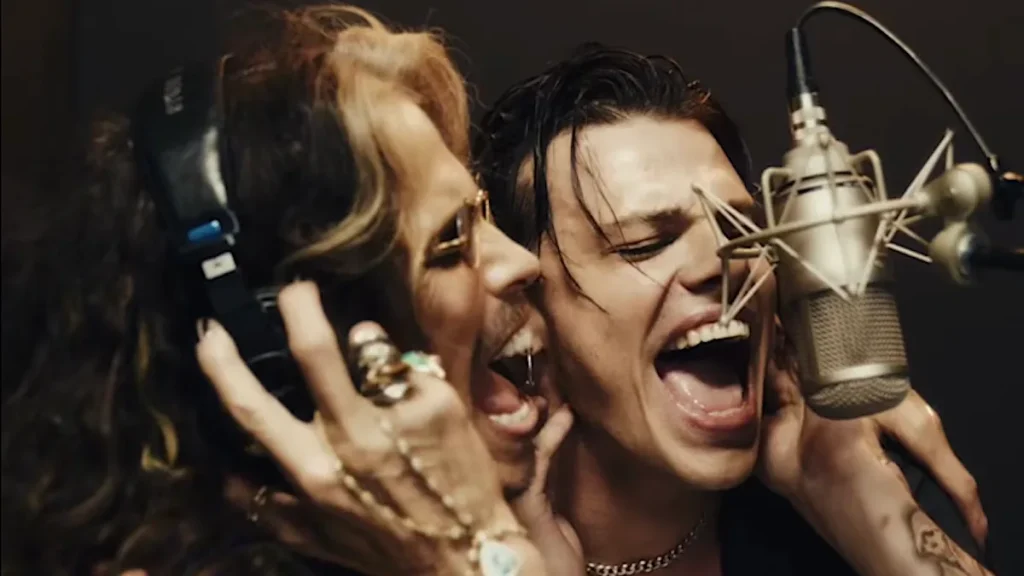Have you ever imagined a song so perfect it feels like it *must* exist? That’s the story of “My Only Angel.” While you won’t find it on any official album, this track is a powerful thought experiment—a fantasy collaboration between the legendary rock gods Aerosmith & Yungblud, the voice of a new, restless generation. It’s a concept that has electrified music forums and social media, representing a symbolic bridge between rock’s past and its defiant future.

The Story and Lyrics Behind the Dream
To truly understand the magic of this hypothetical track, we need to imagine its soul: the lyrics. “My Only Angel” would be a narrative of finding a beacon of hope in a world saturated with digital noise and disillusionment. It’s a story told through two distinct lenses: Steven Tyler’s poetic, world-weary romanticism and Yungblud’s raw, unfiltered angst. The song would explore themes of salvation, rebellion, and the desperate search for authenticity in a manufactured reality. This is our interpretation of the My Only Angel lyrics.
“My Only Angel” – Lyrics
(Verse 1: Steven Tyler)
Streetlights bleedin’ on the rain-slicked glass
Another ghost inside this hourglass
Chasin’ whispers of a love gone past
Yeah, a feelin’ built too wild to last
(Verse 2: Yungblud)
Got static in my head, the screen’s too bright
They’re sellin’ us a dream in black and white
I’m screamin’ at the walls in the dead of night
Just lookin’ for a spark, a guiding light
(Chorus: Tyler & Yungblud)
You’re my only angel in a world of stone
The only real thing that I’ve ever known
When the sirens sing their lonely song
You’re the reason I keep holdin’ on
(Bridge: Tyler & Yungblud)
(Tyler) We’re just two lost souls on a one-way ride…
(Yungblud) But I’ll tear down the sky to be by your side!

Deconstructing the Sound: A Fusion of Eras
As a producer, the thought of blending Aerosmith’s timeless swagger with Yungblud’s chaotic energy is thrilling. The production of “My Only Angel” would be a masterclass in dynamic contrast, a sonic tug-of-war between classic and contemporary rock.
Musical Style and Arrangement
The song would be a Generational Rock Anthem. It would start with a deceptively soft intro—perhaps a melancholic piano melody reminiscent of “Dream On,” setting a cinematic tone. This would quickly be shattered by Yungblud’s entrance, backed by a gritty, slightly distorted guitar riff and a driving, modern beat that incorporates electronic elements like a punchy 808 sub-bass beneath a live drum kit.
The chorus is where the two worlds would collide in spectacular fashion. Imagine Joe Perry’s iconic, blues-drenched Les Paul tone soaring over a wall of sound, while Steven Tyler’s signature scream harmonizes with Yungblud’s passionate, almost-cracking vocals. The result? A chorus that is both epic and emotionally raw.

Production Deep Dive
The key to making this track work would be in the production details. We’d keep the core of Aerosmith’s sound—the organic, powerful drumming of Joey Kramer and Tom Hamilton’s rock-solid bass—but layer it with modern textures. This could include subtle synth pads in the verses to create atmosphere and heavily processed vocal ad-libs from Yungblud that pan across the stereo field, adding a sense of chaos and urgency.
| Element | Aerosmith’s Contribution (Classic) | Yungblud’s Contribution (Modern) | The Fusion |
|---|---|---|---|
| Guitars | Joe Perry’s bluesy, melodic solos and iconic riffs. | Gritty, high-energy power chords; effects-laden textures. | A dynamic interplay between clean, classic tones and raw, modern distortion. |
| Vocals | Steven Tyler’s powerful, melodic screams and soulful phrasing. | Raw, emotional delivery; spoken-word interludes; punk-rock energy. | A call-and-response duet, with soaring harmonies in the chorus. |
| Drums | Powerful, in-the-pocket acoustic drum groove. | Hybrid beats, blending live drums with 808s and electronic samples. | A massive, stadium-rock drum sound with subtle electronic layers for a modern punch. |
| Structure | Classic verse-chorus structure with a bridge and guitar solo. | Unpredictable dynamic shifts; breakdown sections. | A familiar rock structure infused with unexpected drops and builds. |
What Do the “My Only Angel” Lyrics Mean?
The lyrics of “My Only Angel” are a conversation across time. Tyler’s verses paint a picture of timeless loneliness and the search for meaning, using classic rock imagery of rainy streets and fading memories. It’s a narrative we’ve heard from rock legends for decades—the isolation that comes with a life lived in the fast lane.
Yungblud’s verses crash into this with a distinctly modern anxiety. He speaks of “static in my head” and “screens too bright,” grounding the song in the 21st-century struggle against digital overload and societal pressure. His “angel” isn’t just a romantic partner; it’s a symbol of rebellion, a flicker of truth in a world of deepfakes and curated personalities. The lyrics meaning is about finding that one authentic connection—be it a person, a cause, or music itself—that keeps you sane.
The song’s lyrics evoke a sense of finding a single point of light in a vast, lonely landscape.
How to Create a Similar Vibe with Mureka AI
So, this epic collaboration is just a dream… for now. But what if you could capture its essence and create something new with that same energy? This is where AI music creation tools like Mureka come in. As a music creator, I find this incredibly exciting. We can use AI not just to mimic, but to prototype, experiment, and build upon these “what-if” scenarios.
Let’s walk through how you could use Mureka to craft a track inspired by “My Only Angel.”

Step 1: Crafting the Perfect Prompt
The heart of any AI music generator is the prompt. You need to be descriptive. Instead of just saying “rock song,” you need to feed the AI the specific ingredients of our fantasy track. You can start your journey to create music with AI right away.
Prompt Idea for Mureka: “Create a 4-minute rock anthem with a powerful male duet. The style should be a fusion of 80s classic hard rock and modern pop-punk. Start with a slow, emotional piano intro, build into an energetic verse with gritty guitars, and explode into a massive, stadium-sized chorus with soaring vocal harmonies. Include a bluesy, melodic guitar solo after the second chorus. The mood should be epic, emotional, and defiant.”
Step 2: Generating and Refining the Core Idea
Mureka will generate a full track based on your prompt. The first version might not be perfect, but it’s your raw clay. Listen for the elements that work. Maybe the AI nailed the drum groove but the guitar tone is too clean. Or perhaps the chorus melody is great, but the verse feels flat.
This is where Mureka’s editing tools become your best friend. You can use the region editing feature to regenerate specific parts. For example:
- Isolate the guitar track: Rerun the generation with a modified prompt like “make the guitar tone more distorted and aggressive, like modern punk rock.”
- Refine the vocals: If you want to add a spoken-word part like Yungblud might, you can generate a new vocal stem for the bridge with a prompt like “spoken word male vocal, raw and emotional, with a British accent.”

The AI creation process is like blending different sonic colors to create something new.
Step 3: Using Reference Tracks and Stems
One of Mureka’s most powerful features is the ability to upload reference audio. To truly capture the “My Only Angel” vibe, you could:
- Find an instrumental version of Aerosmith’s “Angel” or a similar power ballad.
- Find an aggressive instrumental from Yungblud like “The Funeral.”
- Upload these to Mureka as style references. This gives the AI a much clearer sonic palette to draw from.
Once you have a version you’re happy with, you can download the stems (individual tracks for guitar, bass, drums, vocals). This is where you, the human artist, take over. Import these stems into your DAW (Digital Audio Workstation) like Logic Pro or Ableton Live. Now you can add your own vocals, replace the AI guitar solo with your own performance, or mix and master the track to perfection.

The Bigger Picture: AI, Music, and the Future of Creativity
The concept of “My Only Angel” isn’t just a fun exercise; it highlights a major shift in the music industry. AI music creation is no longer a far-off sci-fi concept. It’s a practical tool that is democratizing music production. For a deeper dive into this revolution, you can explore these AI generated music examples.
The AI Creativity Debate: Tool or Artist?
As we’ve touched on, there’s a vibrant debate about the nature of AI creativity. Current AI models, including those used in music generation, are incredibly sophisticated pattern-recognition machines. They learn the “rules” of music from vast datasets and use them to generate new combinations. They don’t “feel” emotion, but they can recognize and replicate the musical structures that we associate with certain emotions.
“AI in music is best seen as a collaborator—an endlessly patient, knowledgeable assistant that can spark ideas a human might never have considered.” – A sentiment echoed in a 2023 study by the Audio Engineering Society (AES). (2023-10-26)
The real artistry, for now, remains in the human’s ability to guide the AI, to curate its outputs, and to infuse the final product with genuine intent and emotion.

Conclusion: A Symphony of Human and Machine
While My Only Angel by Aerosmith & Yungblud may only exist in our collective imagination, it serves as a powerful symbol. It represents the exciting, genre-bending possibilities that arise when different worlds collide. It also perfectly illustrates the new creative frontier opened up by AI.
With a tool like Mureka, you don’t have to wait for your dream collaborations to happen. You can become the architect of them. You can take the fire of classic rock and fuse it with the fury of modern punk, all from your own studio. The future of music isn’t about humans versus machines; it’s about the incredible things we can create together.
What’s your dream collaboration? Let me know in the comments, and maybe we can figure out how to bring it to life with AI!
